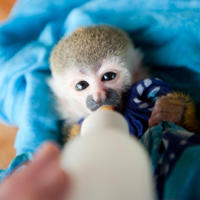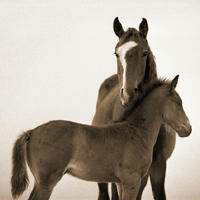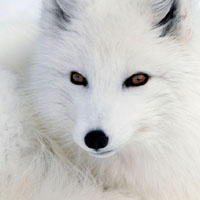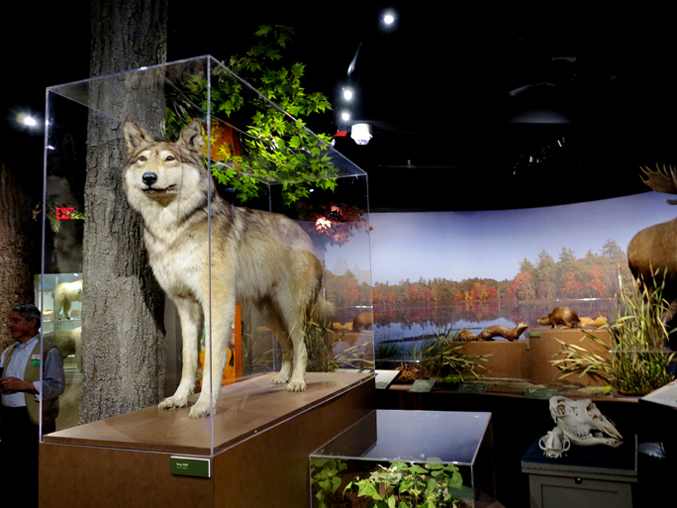
Photo by Zoe Helene
Maggie Howell, executive director of the Wolf Conservation Center, talks about what endangered wolves sacrifice in captivity, the threat they face from hunters and ranchers in the wild, and her love for the lobo.
I drove from Amherst, MA., to the Wolf Conservation Center (WCC) in Salem, NY, to interview executive director Maggie Howell on a hot, humid midsummer day. I’d asked beforehand if I would be able to play with Nikai, an inquisitive “ambassador” pup being closely guarded by a large, wise German Shepard “nanny” named Kai, and WCC curator Rebecca Bose, the wolf pup’s primary caretaker, had set clear boundaries for my play date. I could enter the wolf pups’ sanctuary space, but if Nikai chose not to come to me or let me touch him, I would have to leave without having that experience.
To better my odds with Nikai, I had brought a basket of treats and toys. A dried chicken strip and a no-squeak teething pull-toy were the only two things that met with Rebecca’s approval, but they did the trick. Nanny Kai got a chicken strip first, and then, in a fraction of a second, Nikai dove for his, devoured it, and climbed all over me looking for more. Rebecca promptly confiscated the bag of chicken strips and hid them for later because more might upset his tummy. Tough love.
Nikai didn’t seem to mind. He liked me! He let me rub his belly and the soft golden fuzz on his ears. He was all boy—cuddly, curious, feisty and full of himself in all the right ways. He looked into, rather than at, me with keen, kind, undeniable intelligence. At eight weeks old, Nikai was already carrying out his mission of helping people understand his species by bridging the worlds of wolves and humans—as if he were born for it.
Nikai was, in fact, carefully selected to be a WCC Ambassador Wolf—one of four socialized, captive-bred wolves (charismatic Atka, intense Zephyr, and shy, graceful Alawa) who roam in open spaces, close enough for visitors to make deep eye contact, at WCC’s 26-acre facility in South Salem. WCC, the preeminent facility in the eastern United States for captive breeding of critically endangered wolf species, is also home to about 30 Mexican gray wolves who are being reared for release into the wild through the Species Survival Plan (SSP). Ambassador Wolves are key players in WCC’s mission of helping people understand the species and its complex, controversial, and highly politicized plight.
As Nikai played with the pull-toy—just like the three Siberian Huskies I raised used to—I thought about the sacrifice he’s making. He’s very well cared for and loved dearly, but Nikai will never be free.
Maggie and I talked about that as well as her particular passion for Mexican gray wolves (the smallest and most genetically distinct sub-species of the North American gray wolf known also as the lobo), and the crucial work she and her colleagues are doing to save a species in peril. Because the sad fact is, without efforts by organizations such as WCC, both Mexican gray and Red wolves would still be extinct in the wild and the remaining gray wolves would be right behind them. Before recovery efforts began, the Mexican gray wolf population was down to five: four males and one female who was pregnant with two pups. These last remaining seven lobos were captured alive in Mexico from 1977 to 1980 and transferred to the United States to establish a certified captive breeding program.
“We advocate for wolves’ rights because they cannot speak for themselves,” Maggie told me. “It’s a toxic environment out there when it comes to wolves.”
 Wolf Conservation Center (WCC) • “The most joyful part of this work is releasing wolves into the wild. The worst thing I face in this work is when those wolves get killed.” – Maggie Howell, Wolf Conservation Center
Wolf Conservation Center (WCC) • “The most joyful part of this work is releasing wolves into the wild. The worst thing I face in this work is when those wolves get killed.” – Maggie Howell, Wolf Conservation Center
These wolves are native to the North American West, Southwest and northern Mexico (lobo is Spanish for wolf), and they ran free on those lands from prehistoric times until the last century. Extreme predator removal efforts, sanctioned by the U.S. government from the late 1800s through the mid 1900s, exterminated the species from its wild ancestral landscapes.
Under the Endangered Species Act, reintroduction efforts have established a small population of 109 (latest count as of January 2015) lobos, descendants of the last remaining Mexican gray wolves who were captive bred and released into their native territories. It’s a long, complex, sad story wrought with fear, ignorance and personal gain, where antiquated hunting laws and private (cattle) industry powers get in the way of real progress.
Even with an official protective “endangered” categorization in place, the wild landscape is dangerous for lobos. Because the U.S. Fish and Wildlife Service has designated the species “experimental non-essential”—a loophole that allows extra leniency for “management”—lobos are allowed to roam only in small areas of public land also used by the livestock industry as inexpensive, subsidized grazing land. Occasionally a wolf kills a sheep or a cow, and the “experimental non-essential” designation and accompanying special section 10(j) regulation allows USFWS to remove or even kill the wolf. Wolves who are removed live out their lives at a SSP or fish and wildlife facility. The WCC has some of those wolves.
USFWS’s rationale is that the species isn’t in danger of extinction because its genetics are represented in captivity, but adapting to captivity is weakening the species. This could result—and is resulting—in smaller litters, less successful breeding and decreased pup survival, Maggie told me. The WCC and a coalition of conservation groups have sued the U.S. Fish and Wildlife Service for failing to implement a valid recovery plan for the lobo, Maggie said, because “it’s crucial that the species be allowed to survive in the wild.”
A few highlights from my conversation with Maggie follow.
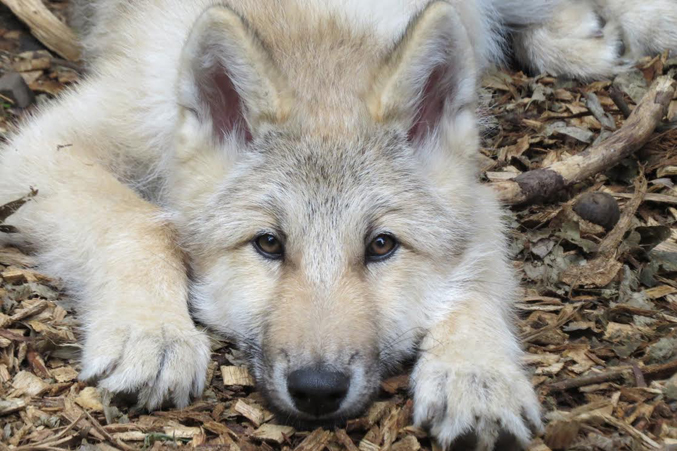
Wolf Conservation Center's Ambassador Wolf Nikai • “I think that there should be more candor when it comes to what goes on behind the scene when recovering species.” – Maggie Howell, Wolf Conservation Center
RESTORING NATURAL BALANCE
What goes on here at the Wolf Conservation Center?
We nurture wolves, advocate for their rights. We teach about 40,000 people a year (adults and kids, but mostly kids) about the importance of wild wolves in the wild landscape. We want people to take more responsibility for better stewardship of our world—and our wild world.
How many wolves live at the Wolf Conservation Center?
We have 24 wolves and 13 Mexican gray wolves here, but they’re not on exhibit for the public. They’re in five different secluded, private enclosures. Our goal is to release them someday into their ancestral wild lands.
You’re also the coordinator for the Northeast Wolf Coalition, an alliance established last year. What’s that all about?
We’re uniting conservation organizations in New York, New England, and beyond to raise awareness and teach people the biological, economic and ethical reasons to facilitate wolf recovery. We’re eager to work with area residents, organizations, and state and federal agencies to promote the wolf’s natural return to our region.
How did we get to this point in the first place? Wasn't it the government that gave the command to massacre the wolves—or was that coyotes?
Basically, it was everything. It was a way to get carnivores, or any other species they felt was in the way, off the landscape. It was about looking out for your livestock and clearing the land for farming. It was also a way to make a living. It was the same way with bison. Have you ever seen that photo from the mid-1870s with the hunter standing in front of a mountain of bison skulls? Mind-blowing.
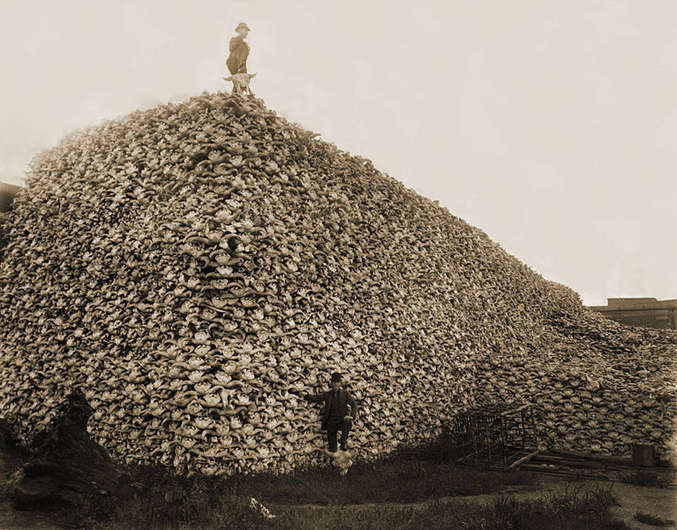 Mountain of American Bison Skulls • A mountain of of American bison skulls waiting to be ground for fertilizer (mid-1870s). Photo courtesy Wiki Commons / Burton Historical Collection, Detroit Public Library
Mountain of American Bison Skulls • A mountain of of American bison skulls waiting to be ground for fertilizer (mid-1870s). Photo courtesy Wiki Commons / Burton Historical Collection, Detroit Public Library
Everyone should know that photo. It should be in every schoolroom, every public library.... It’s one of those “a picture tells a thousand words” images that states the case on our (not-so-distant) cultural history. Those skulls were ground up to be used as fertilizer.
We recently screened a Natural Resources Defense Council video called Wild Things about Wildlife Services, which is a misnamed agency within the USDA that kills off wild animals. Every year, Wildlife Services kills more than 100,000 native carnivores and millions of birds, and they’ve been getting away with this for almost a century. Taxpayers foot the bill.
You see wolves playing a role in the economic system as well.
The economy is the ticket for wildlife. Yellowstone Park and the greater Yellowstone region, for example, have hunting and trapping seasons. Last year it cost Montana residents $19 to go out and kill a wolf. That was the wolf tag price. It seems unbelievable to me to put a money value on a living being. But Yellowstone visitors spend $35 million annually, specifically with the hopes of seeing a wild wolf. For the sake of simplicity, (let’s say that) right now there are about 100 wild wolves in Yellowstone. If you take $35 million dollars and divide it by 100, you get (roughly) a monetary value of about $350,000 per wolf. Plus, these people spend their money at stores and hotels and restaurants so the local economy also benefits. Fewer people are likely to visit Yellowstone if these hunts continue. I was there when the hunts had just started, and it was a weird, negative feeling. I was really careful where I spent my money—where I bought my t-shirt and had dinner and stayed for the night—because a lot of the businesses around the park are run by the very people who are killing wolves.
People don’t understand the economic impacts animals have on us. For instance, most people blame deer for rising rates of Lyme disease, but it’s actually more about the rise in small mammal populations because their predators are dying off. In a healthy ecosystem the fox keep mice populations down. And the annual cost of Lyme disease in the U.S. in 2002 was estimated at $203 million, according to the Centers for Disease Control.
And that’s only counting medical costs. That doesn’t take into account indirect medical costs, nonmedical costs, loss of productivity, and intangible costs of things like a marriage falling apart or a mother or father not being able to care for their own kids because their Lyme is crippling.
It’s a classic example of ecological cascade effect. The spread of Lyme disease is a real problem in the Northeastern United States, which is where I live. Studies show that wherever small mammal populations surge, Lyme disease surges too. But in the regions with a healthy number of wild foxes, the small mammal population is naturally kept in check and reported cases of Lyme decrease. Foxes, which are wild canines, are critical to a system of interactions that contribute to Lyme disease.
Wild canines have a natural order. When there are too many coyotes, which are also wild canines, there are not enough foxes to keep the small mammal populations in check, so Lyme disease thrives. Wolves, which are the highest on the wild canine totem pole, used to keep coyotes populations in check, but our region’s native wolves were hunted to extinction years ago. Without reintroduction, Lyme will continue to thrive because the coyotes no longer coexist with the natural predator they evolved with.
So we “cull” them.
Right. They’re treated like vermin, which is a terrible thing.
According to Project Coyote, an estimated 500,000 coyotes die every year in the U.S. alone — one per minute. They don’t just die. They’re killed.
Wolves keep the coyote population in check. Where there are too many coyotes, the risk of Lyme is higher because the coyotes keep the fox populations down and foxes cull populations of small mammals, which are responsible for the bulk of infectious ticks that carry Lyme disease. If you take away the wolves, you have to “cull” the coyotes—which is a terrible thing. Coyotes are wonderful!
My husband, Chris and I wake each other up to listen to the coyotes when they’re in the woods behind our house, howling. The crazy thing is that coyotes would be kept in check by the wolves if we hadn’t killed enough wolves to upset the natural balance.
That’s true, and it’s the same with bats and mosquitoes. Most people are like, “Oh, bats! You mean those nasty, scary Halloween vampire things?” But then when there’s Dengue fever and malaria and West Nile virus, suddenly bats are very welcome because they consume massive amounts of mosquitoes. We are part of the ecosystem no matter how much we try to remove ourselves.
I support the wild horse warriors, and most of what they’re dealing with is perceived competition for government-subsidized wild rangelands by cattle ranchers.
It's very inexpensive to graze on public land, and most of it is public land. Powerful groups of people are passionate about what is going on with these wild horse roundups, and so much of what is happening with the wolves is very similar. It’s either recreation or industry; in this case it would be the livestock industry trumping the intrinsic rights of many species or the recovery of the species. And it’s sad. And taxpayers’ dollars pay for it.
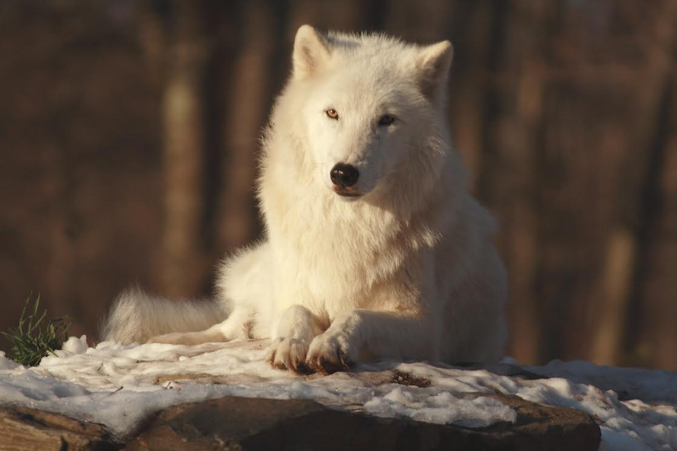
Charismatic Arctic Ambassador Wolf Atka • Ambassador Wolves are key players in WCC’s mission of helping people understand the species and its complex, controversial, and highly politicized plight. The Wolf Conservation Center's "Rock Star", Ambassador wolf Atka has visited over 200 schools, nature centers, museums and libraries helping people learn about the importance of his wild “brothers and sisters”. He loves to travel and has a spectacular howl, which he enjoys sharing with audiences.
MOTHER NATURE’S DOG IN CAPTIVITY
Tell me about your wonderful Ambassador Wolves.
Our ambassadors are raised from a very early age by devoted staff and volunteers. They help teach visitors and students understand the importance of their wild kin through personal interaction. They're really the ones on the front line of the lesson, and they will never live free in the wild.
That’s quite a sacrifice.
It truly is, and it isn’t like they have a choice in the matter. We try to find a new way to thank them for making that sacrifice every single day. We’re constantly asking ourselves, “It is worth it to have these animals in captivity? Are they accomplishing what we need them to do—to act as a conduit that connects wolves and humans so that maybe some of those humans will become better stewards of the planet? Is it worth the sacrifice they make for their wild brothers and sisters, being pulled from their mothers early and raised primarily by humans, living their entire lives in captivity?”
So, is it worth it?
So far I think it is, especially because we're so close to New York City. People who visit us here actually think about wolves when they might not normally think about anything even close to wolves. Through the Ambassador Wolves, they feel a very real connection.
How do wolves get “chosen” to be ambassadors?
We acquire captive-born pups, who we then socialize. There is no “criteria to become an ambassador. They‘re raised to be habituated and to feel comfortable and enjoy being in the company of human beings. All our Ambassador wolves are from exceptional breeding facilities that provide wolves to educational institutions.
It was such a treat to be able to hang out with Nikai!
We only do this with Ambassador pups for about two months with the public. Developing a basic comfort level around people is vital for them to become an educational ambassador and leading a happy and healthy life at the WCC.
What kind of wolf is Nikai?
Like his big brother Zephyr and big sister Alawa, Nikai is a mix of several gray wolf subspecies, mostly Canadian/Rocky Mountain gray wolf. Gray wolves aren’t all gray in color. He’s a very special little guy.
He is indeed. Wolves have such a close kinship to dogs, and so many people are crazy about dogs. You would think that more people would be advocating for wolves.
You’d think. I don't understand why that connection isn’t there. I wish we could get more of the dog people involved. I like to look at the wolf as Mother Nature's dog. But people use dogs to hunt wolves now—which doesn’t even make sense.
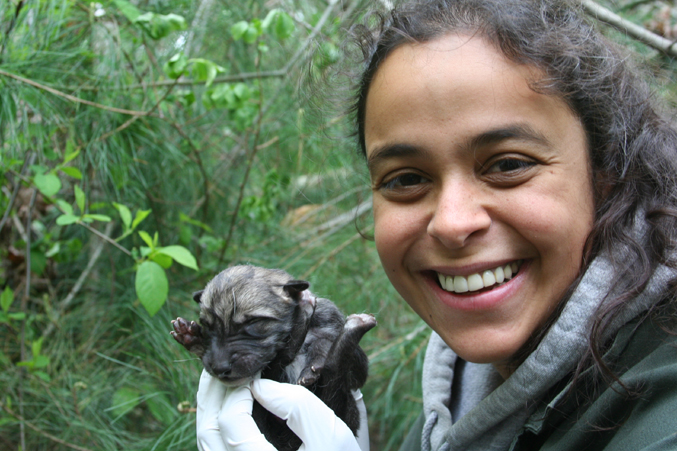 Rebecca Bose with Lobo Pup • “Being curator of these precious critically endangered lobos is a privilege, and holding this amazing new life in my hands is what it’s all about.” – Rebecca Bose, Wolf Conservation Center
Rebecca Bose with Lobo Pup • “Being curator of these precious critically endangered lobos is a privilege, and holding this amazing new life in my hands is what it’s all about.” – Rebecca Bose, Wolf Conservation Center
Wolf Conservation Center’s curator, Rebecca Bose, bottle feeding one of F749’s pups from 2013. Photo courtesy Wolf Conservation Center.
CAPTIVE BREEDING IS A DESPERATE MEASURE
Captive breeding is surely a desperate measure, but if you weren’t doing this, these wolves would be extinct. Mexican Gray Wolves were just about “extinct in the wild,” right?
Yes. The red wolf and Mexican gray wolf were in crisis and about to go extinct in the wild when we took the last remaining wolves into captive breeding programs. The last remaining five lobos, 4 males and a female who was pregnant with 2 pups, were captured to help recover their species by creating a new population. The 2 pups made it, so the founding recovery population was 7.
What’s it like for them in captivity?
Most of our wolves are off exhibit so they don’t become habituated, which means we almost never get to see them—which is hard for us because of course we love wolves. It also means they get appropriate food such as road kill deer—whole carcasses because around here we get plenty of roadkill—and I’m a huge believer in letting animals eat what they’re supposed to eat. They can also hunt within their fenced-in territories. They have a lot of natural social interactions. We let them be wolves as much as we can because how better to prep them for the wild?
And you have an important female.
We do. Her name is Mexican wolf F749, and she’s one of twelve lobos who live at the WCC off-exhibit. She’s the most genetically valuable wolf to the program in the United States.
Wow.
Wow—but poor her! It’s a heavy onus.
Tell me about her.
She’s had many different mates, and she's proved fruitful most times. F749 is a perfect example of why it’s too bad that genetics has to be such a major issue governing recovery for the lobos. She’s the most valuable example of a Mexican gray wolf in the recovery program in the United States, so a lot of eyes are on her because we want her genes represented in younger wolves. But because of that, she’s chosen to breed over and over again, with different mates. She seems to get along with everyone pretty well, and she’s extremely fertile, but we’ve hosted three or four breeding pairs per year over the past five years, and most of the time we don’t have pups.
Why?
These are arranged marriages, and they might get along but may not necessarily want to start a family. And who knows? There might be a lot of natural selection when it comes to picking a mate, just like any other species.
But she’s had pups?
Yes. She was transferred here from the California Wolf Center (CWC) in 2011. She had lived there for some time and she had pups there too. But when left in her care, most of her puppies did not survive.
So she could have them but she didn’t care for them well?
We don’t know. It could have been a genetic issue, that the wolves weren’t healthy. If an elusive wolf has pups and then they die, you’re not necessarily going to find them or see what happened. It’s hard for us to determine cause of death. When we perform a necropsy (an autopsy for animals) we can sometimes have a better idea of what happened.
Tell me about the eight puppies in the photo and video. What happened?
In her first spring here at the WCC, F749 bred with a wolf named M740, who has since passed away. They had eight pups. Everyone was watching and very excited because these pups were very valuable genetically. Rebecca Bose, our curator and primary handler in charge of the well being of all our wolves, was watching on the live cam and could see that the mother was nervous and moving her pups around a lot. She just kept moving them around and moving them around, and the last time we saw a pup alive it was a month old. Then—nothing. They all died.
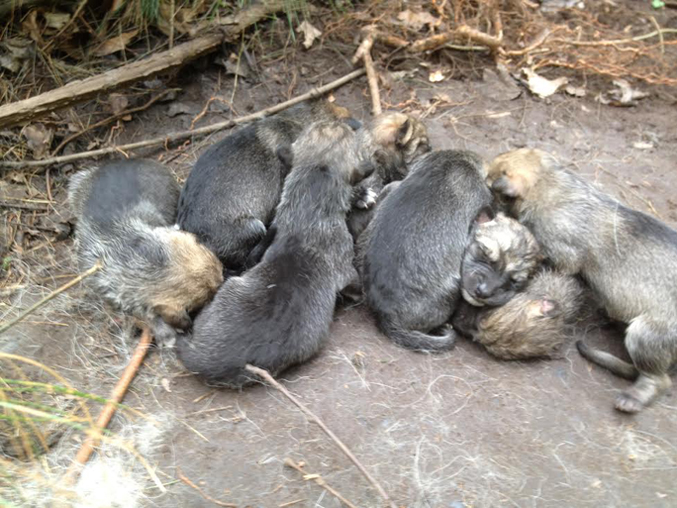 Wolf F749's 8 Newborn Pups • None of Wolf 5749’s 8 beautiful puppies survived. All of them died. “If you’re breeding wolves in captivity, there’s a high risk of having adaptation to captivity—and that’s genetic.”– Maggie Howell, Wolf Conservation Center
Wolf F749's 8 Newborn Pups • None of Wolf 5749’s 8 beautiful puppies survived. All of them died. “If you’re breeding wolves in captivity, there’s a high risk of having adaptation to captivity—and that’s genetic.”– Maggie Howell, Wolf Conservation Center
That’s terrible! So after the eight puppies died and then the father of those puppies also died, the mother was chosen to breed again?
She was. The following year (which was last year) she was introduced to a new guy, M804. The best guy ever! They paired off immediately, and she got pregnant right away. It was so sweet to watch her with the new guy. With the litter of eight pups she wouldn’t let the male anywhere near the nest she’d made. She was always chasing him off—but this new guy, he was waiting right outside while she was giving birth.
So did they have pups?
They had two pups, and we were told that we had to pull them both.
Oh no!
Be careful what you wish for. We begged the Species Survival Program—the government agency we report to—to let her keep just one. They said the pups were too valuable and we couldn’t risk it.
So what happened?
We pulled the puppies when they were 18 hours old and flew them to a facility where a woman had good experience hand rearing pups and had a pair of lobos who had successfully fostered pups. It was touch-and-go with one of the pups, but both of them made it. Two males are alive and well and living in Indiana, so her genes are represented.
Wow. That’s heavy.
This happened around Mother’s Day, and we got slammed by our supporters. But it allowed us to open this discussion. I’m always looking for the silver lining. It’s good for everybody to see how screwed these animals are and what we have to do once they get to that point. It was devastating, but it was also a unique opportunity in that sense.
Did the mother wolf grieve over her lost pups?
She stayed in the den quite a bit, and the male stayed right outside the den waiting for her for about three days, and then they got their first meal—a whole deer—and everything appeared to be status quo. I have no idea what she’s thinking or feeling, but it had to be terribly upsetting to have those pups taken away.
I couldn't have done it.
I know. I hear you. And I lobbied too, but, unfortunately, it’s not our choice. It’s a hotly debated topic, and we are getting a discussion going, and I think that's good—not only for us, but also for the people leading in this program. I’m very candid. We don’t share enough with the general public. How can people have a greater respect for science if they're not allowed to learn and discuss it? There’s a social component to the science of recovering a species. We are a part of this fabric as well, and as human beings, social beings, we should learn from and discuss these things. I think that there should be more candor when it comes to what goes on behind the scene when recovering species.
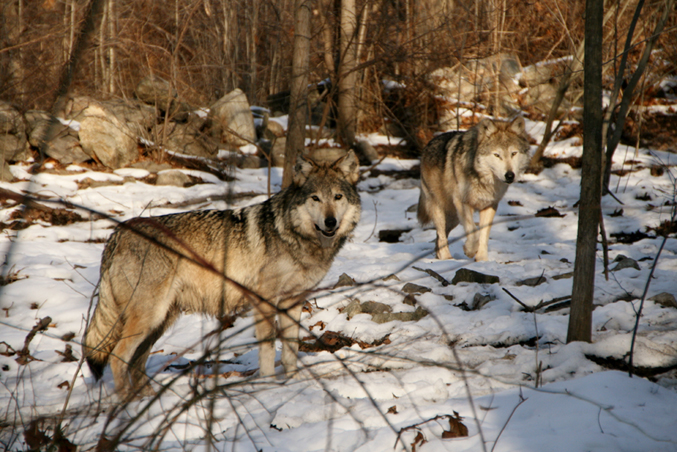 F749 (left) and M804 (right) • “The following year (which was last year) she was introduced to a new guy, M804. The best guy ever! They paired off immediately, and she got pregnant right away. It was so sweet to watch her with the new guy.” – Maggie Howell, Wolf Conservation Center
F749 (left) and M804 (right) • “The following year (which was last year) she was introduced to a new guy, M804. The best guy ever! They paired off immediately, and she got pregnant right away. It was so sweet to watch her with the new guy.” – Maggie Howell, Wolf Conservation Center
Last year at this time F749 was pregnant and we were coordinating my visit in time to see F749 and M804’s new puppies. What happened?
Ultrasound revealed at least four pups in her belly—and they all had strong heartbeats. We put a video cam in her den when she was ready to have them. She was 12 at that point, which is pretty old for a wolf to have pups, so we kept a close watch. We saw that she only had one puppy, and she was cleaning it. And she just kept cleaning it and cleaning it. Then finally, 18 hours after giving birth, she came out of her den for the first time, leaving the her puppy behind. Mexican gray wolf F749 had given birth to a single stillborn pup. The puppy was female.
What happened to the other three puppies that had showed up in the ultrasound?
We don’t know. All four puppies in the ultrasounds had strong heartbeats. We think she probably reabsorbed them. Early on during the gestation period—up to three months—wolves can reabsorb fetuses.
Will she get another chance?
No. And I think this is good, actually. After this season she will be spayed, which is the best thing we could do for her. Just let her live and not have to be this puppy machine any longer.
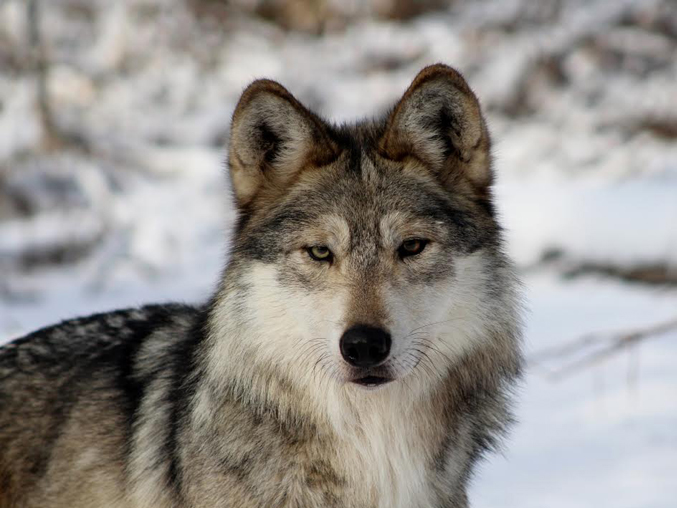 M1198 • “F749 and M804 are no longer a pair, and she was spayed February 3, 2015, and her ovaries were sent to the St Louis Zoo where they will extract all viable oocytes and preserve them on ice for future use. Her soul mate, M804 has been paired with a younger female for breeding, F749 is with M1198, a younger male, for companionship.” – Maggie Howell, Wolf Conservation Center
M1198 • “F749 and M804 are no longer a pair, and she was spayed February 3, 2015, and her ovaries were sent to the St Louis Zoo where they will extract all viable oocytes and preserve them on ice for future use. Her soul mate, M804 has been paired with a younger female for breeding, F749 is with M1198, a younger male, for companionship.” – Maggie Howell, Wolf Conservation Center
Do you think that these soul mates will stay together?
We had hoped so because they are really so sweet together, and for a while they lived together off-exhibit. I love them together, so I'm glad at the end of the day they at least they had each other for a time. F749’s reproductive career was never in her own paws (hands). They are no longer a pair, and she was spayed February 3, 2015, and her ovaries were sent to the St Louis Zoo where they will extract all viable oocytes and preserve them on ice for future use. Her soul mate, M804 has been paired with a younger female for breeding, F749 is with M1198, a younger male, for companionship.
How does F749 get along with M1198? He’s spectacular!
He is. They get along fine. They’ve been separated by a fence for a month or so because we didn’t want them to breed. Now that she’s been spayed, she’ll join him in a day or two.
This poor mother has gone through hell. Do you think her 2 out of 19 pup-survival score has to do with captive breeding? It seems like a lot of deaths for one healthy female.
If you’re breeding wolves in captivity, there’s a high risk of having adaptation to captivity—and that’s genetic. Evolution happens very slowly in many cases, but in a vacuum it can happen very quickly. It’s clear that the captive breeding program is not infinitely sustainable. Ongoing loss of founder genome equivalents, an aging population, lack of space and inevitable selection for traits more suited to captivity than the wild are all real issues.
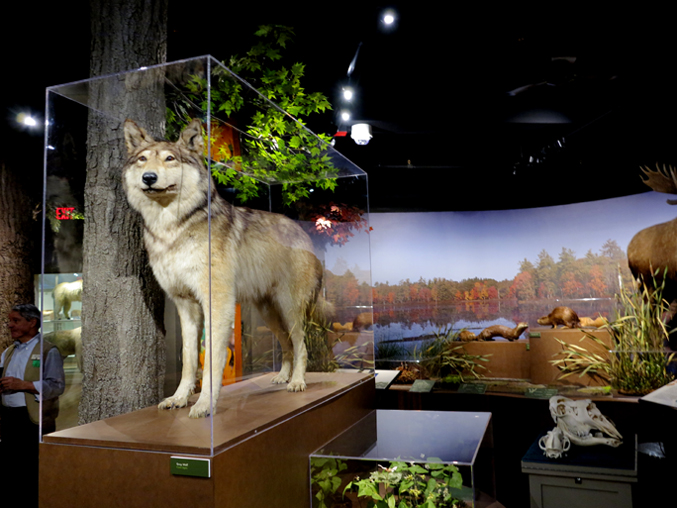
Extinct Wolf in New England Forests Exhibit ♥ Wolves have already been rendered extinct in their native New England territories. Special thanks to the Harvard Museum of Natural History for permission to photograph their New England Forests exhibit.
SOMETHING MUCH BIGGER
Do the wolves have names other than the numbers?
We keep the alphanumeric names for the educational component and also because we want people to realize that these wolves are something much bigger than just our facility or their pack. They are part of a desperate recovery of their species. These wolves are making a huge sacrifice for the good of recovering their species, and only some of them actually get the opportunity to be wild. Wolf F749 knows her name. The wolves in her pack know her name. I think wolves have names for each other, don’t you?
They must! How do you decide which captive-bred wolves get released into the wild?
Genetics governs most decisions. They look for wolves that will enhance gene pool diversity in the wild landscape. Behavior and health also play a role. A wolf that's been on exhibit his or her whole life and likes people is not a good candidate for release. The wolves most likely to be released because of genetics are placed in facilities where they can be kept off exhibit so they don’t habituate.
What exactly does the world word “habituate” mean?
It’s when wild animals become accustomed to a human being. Really, it means that they're not responding to humans the way they’re naturally supposed to. Most wild wolves are naturally fearful of people—or perhaps have learned to become fearful of people because they should be.
Many people are fearful of wolves! Because our culture insists on continuing to teach children that wolves want to eat us.
And we’re not on the menu. We’re just not the type of animal that a wolf will be looking to eat—unless they were truly desperate and there was just nothing else.
You would think that as a culture we could mature beyond believing in fairytales with antiquated ideas and villains based on ignorance! It must be difficult to fight that. What's the most challenging and difficult thing you face in this work?
The worst thing I face in this work is when our wolves get killed. It's always a risk when you’re doing the absolute best thing for them, which is releasing them into the wild, and then they’re killed by criminals. Our first two wolves that were released were both were illegally shot and killed very shortly after we released them.
What are some of the most joyful things you get to experience with this work?
The most joyful part of this work is releasing wolves into the wild.
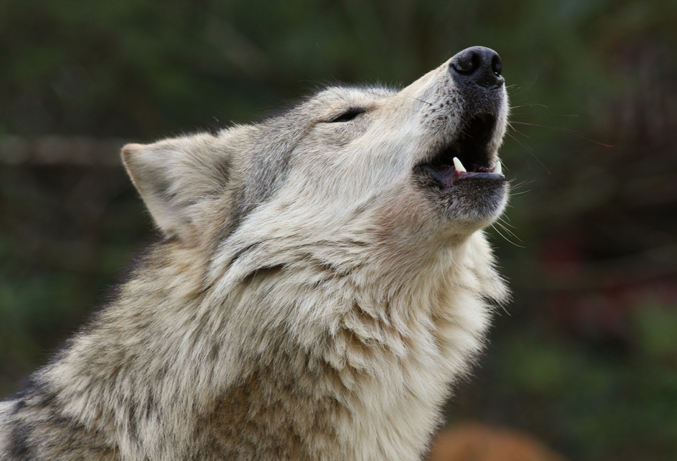 #Loboweek • The Wolf Conservation Center (@nywolforg) and a consortium of wolf-advocacy groups have declared March 23 through March 29 as #LoboWeek in an effort to get the word out.
#Loboweek • The Wolf Conservation Center (@nywolforg) and a consortium of wolf-advocacy groups have declared March 23 through March 29 as #LoboWeek in an effort to get the word out.
LIVE WEBCAMS
Ambassador Wolves Zephyr, Alawa, and Nikai
Mexican Gray Wolf F613 and Children
The enclosure cameras were made possible by a grant from Patagonia.
ONLINE RESOURCES
Wolf Conservation Center (@nywolforg)
Northeast Wolf Coalition (@NEwolforg)
Species Survival Plan
Endangered Species Act
Natural Resources Defense Council (@NRDC)
Project Coyote (@ProjectCoyote)
Yellowstone Park (@YellowstoneNPS)
U.S. Fish and Wildlife Service
Special thanks to the Harvard Museum of Natural History for permission to photograph their New England Forests exhibits.
